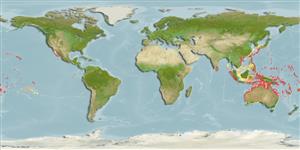Environment: milieu / climate zone / depth range / distribution range
Ekologi
laut berasosiasi dengan karang; kisaran kedalaman 4 - 40 m (Ref. 90102), usually 27 - 30 m (Ref. 9710). Tropical
Western Pacific: southern Japan to the Great Barrier Reef, east to Pitcairn, west to Western Australia.
Size / Weight / umur
Maturity: Lm ? range ? - ? cm
Max length : 15.0 cm TL jantan/; (Ref. 48636)
Duri punggung (Keseluruhan (total)) : 5; duri punggung lunak (Keseluruhan (total)) : 21; Duri dubur: 1; Sirip dubur lunak: 16 - 17. Recognized by the double lines of dashes over the back (Ref. 48636). Lower two-thirds of body whitish with 8 narrow red bars, each containing 2 dark spots (black or darker red), one at of bar and one at level of lower third of body. A small dark red to black spot on abdomen above base of pelvic fins. Spinous portion of dorsal fin cream with a broad oblique black bar (except posteriorly). Scales on opercle cycloid (Ref 42740).
Mainly occurs at moderate depth on open rubble reef flats, but occasionally more shallow on outer reef habitats (Ref. 48636). Usually on rubble or sand near coral reefs (Ref. 42740) solitary or forms small groups (Ref. 90102).
Life cycle and mating behavior
Maturities | Reproduksi, perkembang biakan | Spawnings | Egg(s) | Fecundities | Larva
Randall, J.E., G.R. Allen and R.C. Steene, 1990. Fishes of the Great Barrier Reef and Coral Sea. University of Hawaii Press, Honolulu, Hawaii. 506 p. (Ref. 2334)
Status IUCN Red List (Ref. 130435)
ancaman kepada manusia
Harmless
penggunaan manusia
Perikanan: tidak ada kepentingan
Alat, peralatan
laporan khas
muat turun XML
Sumber internet
Estimates based on models
Preferred temperature (Ref.
123201): 24.2 - 28.5, mean 26.9 °C (based on 46 cells).
Phylogenetic diversity index (Ref.
82804): PD
50 = 0.5000 [Uniqueness, from 0.5 = low to 2.0 = high].
Bayesian length-weight: a=0.00692 (0.00311 - 0.01538), b=3.06 (2.88 - 3.24), in cm total length, based on LWR estimates for this Genus-body shape (Ref.
93245).
Trophic level (Ref.
69278): 3.5 ±0.4 se; based on size and trophs of closest relatives
Daya lenting (Ref.
120179): Tinggi, Waktu penggandaan populasi minimum kurang dari 15 bulan (Preliminary K or Fecundity.).
Fishing Vulnerability (Ref.
59153): Low vulnerability (10 of 100).
Nutrients (Ref.
124155): Calcium = 110 [59, 172] mg/100g; Iron = 0.719 [0.451, 1.168] mg/100g; Protein = 18.1 [15.8, 20.0] %; Omega3 = 0.102 [0.062, 0.174] g/100g; Selenium = 29.9 [15.5, 58.9] μg/100g; VitaminA = 102 [36, 283] μg/100g; Zinc = 1.64 [1.12, 2.31] mg/100g (wet weight);
